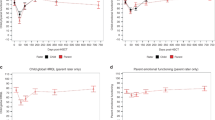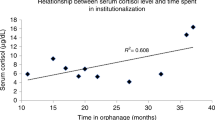Abstract
Previous studies have reported increased rates of social difficulties in children treated by haematopoietic cell transplant (HCT). This study assessed social functioning in children with congenital immunodeficiency treated by HCT and investigated two potential underlying mechanisms that may explain social difficulties: executive function skills and physical appearance. In total, 31 children (8–16 years of age) were assessed on measures of social functioning and peer relationships, executive function and physical appearance. Results were compared with a control group of 31 healthy children, matched for age, gender, ethnicity and cognitive ability. Parent, teacher and self-report data were collected. HCT survivors were described by parents and teachers, but not by themselves, as experiencing more difficulties with social functioning than the control group. Executive function was not associated with social functioning. However, an objective measure of physical appearance was significantly associated with social functioning. Results suggest that children treated by HCT for congenital immunodeficiency do experience significant difficulties in social functioning, not solely accounted for by below average intelligence. These difficulties are associated with physical appearance, but not with executive functional skills. This has clinical implications for identifying and treating children at increased risk of difficulties with social functioning.
This is a preview of subscription content, access via your institution
Access options
Subscribe to this journal
Receive 12 print issues and online access
$259.00 per year
only $21.58 per issue
Buy this article
- Purchase on Springer Link
- Instant access to full article PDF
Prices may be subject to local taxes which are calculated during checkout
Similar content being viewed by others
References
Rogers MH, Lwin R, Fairbanks L, Gerritsen B, Gaspar HB . Cognitive and behavioral abnormalities in adenosine deaminase deficient severe combined immunodeficiency. J Pediatr 2001; 139: 44–50.
Titman P, Pink E, Skucek E, O’Hanlon K, Cole TJ, Gaspar J et al. Cognitive and behavioural abnormalities in children following haematopoietic stem cell transplantation for severe congenital immunodeficiencies. Blood 2008; 112: 3907–3913.
Deater-Deckard K . Annotation: recent research examining the role of peer relationships in the development of psychopathology. J Child Psychol Psychiatry 2001; 42: 565–579.
Parker JG, Asher SR . Peer relations and later personal adjustments: Are low accepted children at risk? Psychol Bull 1987; 102: 357–389.
Arvidson J, Larsson B, Lonnerholm G . A long term follow up study of psychosocial functioning after autologous bone marrow transplantation in childhood. Psycho-Oncology 1999; 8: 123–134.
Kupst MJ, Penati B, Debban B, Camitta B, Pietryga D, Margolis D et al. Cognitive and psychosocial functioning of pediatric hematopoietic stem cell transplant patients: A prospective longitudinal study. Bone Marrow Transplant 2002; 30: 609–617.
Phipps S, Dunavant M, Srivastava DK, Bowman L, Mulhern RK . Cognitive and academic functioning in survivors of pediatric bone marrow transplantation. J Clin Oncol 2000; 18: 1004–1011.
Phipps S, Mulhern RK . Family cohesion and expressiveness promote resilience to the stress of pediatric bone marrow transplant: a preliminary report. Dev Behav Pediatr 1995; 16: 257–263.
Vanatta K, Zeller M, Noll RB, Koontz K . Social functioning of children surviving bone marrow transplantation. J Pediatr Psychol 1998; 23: 169–178.
Phipps S, Rai S, Leung WH, Lensing S, Dunavant M . Cognitive and academic consequences of stem-cell transplantation in children. J Clin Oncol 2008; 26: 2027–2033.
Noll RB, Gartstein MA, Vanatta K, Correll J, Bukowski WM, Davies WH . Social, Emotional and Behavioural Functioning of Children with Cancer. Pediatrics 1999; 103: 71–78.
Reiter-Purtill J, Gerhardt CA, Vanatta K, Passo MH, Noll RB . A controlled longitudinal study of the social functioning of children with juvenile rheumatoid arthritis. J Pediatr Psychol 2003; 28: 17–28.
Booth-Jones M, Jacobsen PB, Ransom S, Soety E . Characteristics and correlates of cognitive functioning following bone marrow transplantation. Bone Marrow Transplant 2005; 36: 695–702.
Harder H, Cornelisson JJ, Van Gool AR . Cognitive functioning and quality of life in long-term adult survivors of bone marrow transplantation. Cancer 2002; 95: 183–192.
Fisher J, Barkley R, Smallish L, Fletcher K . Executive functioning in hyperactive children as young adults: Attention, inhibition, response perseveration, and the impact of comorbidity. Dev Neuropsychol 2005; 27: 107–133.
Seguin JR, Boulerice B, Hardin PW, Tremblay RE, Phil RO . Executive functions and physical aggression after controlling for attention deficit hyperactivity disorder, general memory, and IQ. J Child Psychol Psychiatry 1999; 40: 1197–1208.
Lopez BR, Lincoln AJ, Ozonoff S, Lai Z . Examining the relationships between executive functions and restrictive, repetitive symptoms of autistic disorder. J Autism Dev Disord 2005; 35: 445–460.
Hartup WW . Peer relations. In: Hetherington EM (ed.). Handbook of Child Psychology: Vol. 4. Socialization, Personality and Social Development. Wiley: New York, 1993, pp 102–196.
Reiter-Purtill J, Waller JM, Noll RB . Empirical and theoretical perspectives on the peer relationships of children with chronic conditions. In: Roberts MC and Steele RG (eds). Handbook of Pediatric Psychology, 4th edn, Chapter 45. Guildford Press: London, 2009.
Nadeau L, Tessier R . Social adjustment of children with cerebral palsy in mainstream classes: Peer perception. Dev Med Child Neurol 2006; 48: 331–336.
Wechsler D . Wechsler Intelligence Scale for Children, 3rd edn. Psychological Corporation: UK, 1991.
Goodman R . The Strengths and Difficulties Questionnaire: a research note. J Child Psychol Psychiatr 1997; 38: 581–586.
Goodman R, Ford T, Richards H, Gatward R, Meltzer H . The development and well-being assessment: description and initial validation of an integrated assessment of child and adolescent psychopathology. J Child Psychol Psychiatr 2000; 41: 645–655.
Sparrow SS, Balla DA, Cicchetti DV . Vineland Adaptive Behaviour Scales: Interview Edition Survey form Manual. American Guidance Service: Circle Pines: MN, 1984.
Rubia K, Smith A, Taylor E . Performance of children with attention deficit hypperactivity disorder (adhd) on a test battery of impulsiveness. Child Neuropsychol 2007; 13: 276–304.
Korkman M, Kirk U, Kemp S . NEPSY: A Developmental Neuropsychological Assessment, Manual. The Psychological Corporation: UK, 1998.
Cohen J . Statistical Power Analysis for the Behavioural Sciences, 2nd edn. Lawrence Earlbaum Associates: Hillsdale, NJ, 1988.
Benjamini Y, Hochberg Y . Controlling for false discovery rate—A practical and powerful approach to multiple testing. J R Stat Soc B Met 1995; 57: 289–300.
Canning EH, Canning RD, Boyce WT . Depressive symptoms and adaptive style in children with cancer. J Am Acad Child Adolesce Psychiatry 1992; 32: 1120–1124.
Cicchetti D, Cohen DJ . Perspectives on developmental psychopathology. In: Cicchetti D & Cohen DJ (eds). Developmental Psychopathology: Vol. 1. Theory and Methods. Wiley: New York, 1995, pp 3–20.
Author information
Authors and Affiliations
Corresponding author
Ethics declarations
Competing interests
The authors declare no conflict of interest.
Rights and permissions
About this article
Cite this article
Skucek, E., Butler, S., Gaspar, H. et al. Social outcome in children treated by haematopoietic cell transplant for congenital immunodeficiency. Bone Marrow Transplant 46, 1314–1320 (2011). https://doi.org/10.1038/bmt.2010.318
Received:
Revised:
Accepted:
Published:
Issue Date:
DOI: https://doi.org/10.1038/bmt.2010.318
Keywords
This article is cited by
-
Quality of Life and Social and Psychological Outcomes in Adulthood Following Allogeneic HSCT in Childhood for Inborn Errors of Immunity
Journal of Clinical Immunology (2022)
-
Life with a Primary Immune Deficiency: a Systematic Synthesis of the Literature and Proposed Research Agenda
Journal of Clinical Immunology (2016)
-
Quality of Life in Children with Primary Antibody Deficiency
Journal of Clinical Immunology (2014)
-
A systematic review and meta-analysis of changes in cognitive functioning in adults undergoing hematopoietic cell transplantation
Bone Marrow Transplantation (2013)



